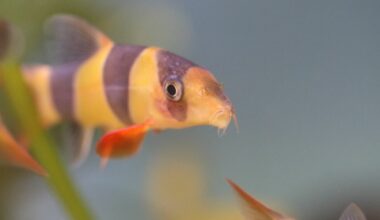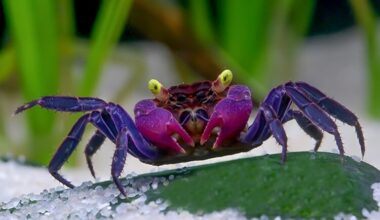If you’re seeking a captivating addition to your home aquarium, the Mimic Tang is sure to mesmerize you with its remarkable mimicry and vibrant appearance. As their name suggests, these intelligent creatures are masters of deception, using their mimicry skills to blend in with other species for protection.
Whether you’re an experienced aquarist or embarking on your first fish-keeping adventure, this care guide will provide you with essential tips and insights to ensure the well-being of your captivating Mimic Tang. So, let’s dive into the mesmerizing world of Mimic Tang care and unlock the secrets to keeping this extraordinary fish in your own aquarium!
Table of Contents
Species Summary
Mimic Tangs (Acanthurus pyroferus) are some of the most beautiful species you can add to your aquarium! These fish mimic the colors and patterns of the angelfish around them when juvenile. This camouflage adds a sense of protection until they become adults!
The Mimic Tang is part of the Surgeonfish family. Other names used for this breed include Chocolate Tang, Chocolate Surgeonfish, and Lemonhead Mimic Tang. The species has an aggressive behavior pattern that helps them defend their territory in the wild.
Mimic Tangs primarily reside in the Indo-Pacific Sea. They stretch south to the Great Barrier Reed and north to the southern coast of Japan. They are most active in daylight hours, coming out to feed three times. Mimic Tangs tend to sleep among the rocks in the reef at night.
Appearance
Mimic Tangs get their name from the angelfish they camouflage as when juvenile. The young fish have different colorations, depending on the dwarf angels close to them. The only element all Mimic Tangs have in common is their oval-shaped bodies.
Author Note: The Mimic Tang is like having different fish in one since it takes on a different appearance as it becomes older. Eventually, the body color will darken, becoming black or dark tan.
Some of these fish still have yellow highlights in these darker shades. Sometimes, the areas around the eyes have yellow and red marks. The dorsal fins have faint yellow and green highlights for a unique appearance on some of these fish.

Lifespan
Some scientists have difficulty deciphering Mimic Tangs from other angelfish close to them. Remember, these fish camouflage themselves to stay safe when young. Adults will lose their stripes and bright colors as they get older.
Most lifespan information comes from aquarium owners who keep Mimic Tangs in their homes. With the best setup, you can expect your fish to live as long as ten years! The general lifespan of a Mimic Tang is around eight to 10 years.
Average Size
Mimic Tangs retain the size of the Pygmy angelfish around them when juvenile. They are tiny and take some time to grow. You can buy these fish when they are about 2.5 inches long. Mimic Tangs reach their full size between three and five years old.
Male Mimic Tangs are slightly longer than females. The size of an adult Mimic Tang can be as much as 10 inches! You can expect one in your home to stay around seven or eight inches long, as this size is average.
Mimic Tang Care
Mimic Tangs are perfect for beginner aquarium owners! They are easy to care for and have a long lifespan. These fish will eat quickly without any issues.
One of the best considerations when caring for a Mimic Tang is the aquarium conditions. Keep them well-fed, and the tank should be a decent size. Ensure the water has plenty of movement and oxygenation for the fish’s health.
Author Note: It is important to not change the water too quickly, as the Mimic Tang can be sensitive to these issues.
Tank Size
Your aquarium tank should be able to hold at least 90 gallons to create the best environment for your juvenile Mimic Tangs. Provide ample hiding spots for your fish, as they prefer to sleep under rocks or in coral. Remember, Mimic Tangs do not openly welcome newcomers, especially other Tangs, in their territory.
Adult Mimic Tangs do better in a 125-gallon tank. They will love the open swimming space if it has heavy circulation. Your water should also have plenty of oxygen to keep your fish healthy.
Water Parameters
- Water Temperature: 72-78°F
- pH Levels: 8.1 to 8.4
- Water Hardness: 8 to 12 dKH
- Specific Gravity: 1.020 to 1.025
Tank Setup
Try to add live rock that resembles a coral reef in your aquarium. These fish like to sleep in secure hiding spots. Add holes and caves where your Mimic Tangs can hide and get cover.
You must maintain a healthy balance of open swimming space and hiding spots. You want to keep your fish happy and stress-free to live a long life. These creatures love to swim but hide if they feel threatened by larger fish.
Author Note: Since Mimic Tangs are herbivores, they do well in a reef aquarium. They will eat the algae from the corals to keep every organism healthy. Look for the more durable reef, as these fish like moving water.
Lighting
Mimic Tangs do not have any special lighting requirements. They are most active during the day and sleep at night.
Filtration
Keep your aquarium as clean as possible for your Mimic Tangs. They require regular filtration and cleanings to have the most healthy lives. Mimic Tangs will eat away algae on coral reefs to help in this process. Ensure that your filter can handle the volume of your tank.
Author Note: Provide plenty of oxygenation in the water of the Mimic Tang’s tank. They will not survive if oxygen levels drop below two ppm. Mimic Tangs need well-oxygenated waters to maintain respiration in their active lifestyles.
Mimic Tangs also prefer a strong current in their aquarium tanks. Use a power head to add some movement to your water. Your fish will want to swim against the provided resistance levels.
Acclimation
You are better off buying a juvenile Mimic Tang when setting up your tank. Thankfully, it is nearly impossible to find adult versions of these fish in the trade market. Mature Mimic Tangs do not acclimate well to a new aquarium environment.
Juveniles tend to acclimate to new aquarium conditions without many problems. Use the slow drip method to minimize stress levels with your Mimic Tangs. This process allows the fish to become comfortable in the provided water conditions. Your Mimic Tangs can stay in the slow drip environment for about an hour.
Are Mimic Tangs Reef-Safe?
Mimic Tangs are extremely reef safe! They live among the coral and live rocks in the wild. Mimic Tangs even sleep among the caves and under shelter in these environments! Mimic Tangs love to explore their surroundings and want to have hiding spots where they can stay away from predators.
Mimic Tangs are herbivores and will never nibble on coral polyps. These fish will only eat the macroalgae that line some of the reefs. Mimic Tangs will help keep your tank clean and let your coral live longer!
Common Possible Diseases & Prevention
Marine diseases are some of the most common afflictions that Mimic Tangs face. These fish could encounter HLLE, marine ich, and velvet infections in your aquarium. Algae consumption and other preventative methods will help your Mimic Tangs stay healthy.
HLLE, also known as Head and Lateral Line Erosion disease, comes from high-stress levels and malnutrition. Avoid this condition by acclimating your Mimic Tangs to their new tanks using the slow drip method. A healthy diet will also help your fish remain healthy.
Author Note: Marine ich and velvet infections come from pre-existing parasites. You can keep your fish in quarantine to look out for these conditions before adding them to your tank.
Food & Diet
The diet of Mimic Tangs is herbivorous and they enjoy eating the algae in your tank. Add a refugium or veggie clip to their diets to further supplement their health. These fish need greens to boost their health. A poor-functioning immune system can lead to infections and other aggressive behaviors.
Add protein to your Mimic Tang’s diet to enhance their color and scales. Most frozen foods will help to accommodate these needs. You can feed your fish brine shrimp or krill to help increase their protein intake.
Author Note: It is best to provide food to your Mimic Tangs at least three times per day. A Tang could start overeating if you do not feed it properly. Malnutrition can also lead to more aggressive behaviors.
Behavior & Temperament
Mimic Tangs can display some aggressive behaviors towards other Tangs especially. In the wild, juveniles get attacked for food by damselfish. They have to learn to survive to get regular meals.

Mimic Tang Tank Mates
Do not put other angelfish into your tank, most of the time. The fish could start to attack one another, as they will feel as if they have to fight over their food. In rare situations, you can add more Tangs for more color in your aquarium.
Add other Tangs to your tank if they are around the same size, there are no similarities and if you add them simultaneously. Keep an eye on every fish to ensure no fights erupt. Most of the time, this situation will lead to added tolerance.
For example, a large tank can house:
- Naso Tang
- Yellow Tang
- Hippo Tang
The Mimic Tang does relatively well with other reef fish. They will become more territorial when you do not feed them as much as they should or if they have too small of a tank. Make sure to follow the above recommendations to avoid these predatory behaviors.
Breeding
This species has not been bred in a home aquarium. It is impossible to distinguish Mimic Tang males and females. They look almost the same! Consider that two Mimic Tangs should never go in the same tank. They will fight each other, unlike other generic Tangs.
In the wild, Mimic Tangs release their eggs into plankton. You nearly cannot replicate this situation in a home aquarium. The male and female will also need ample space to swim together to release the eggs. It is best to allow these fish to breed in the wild.
Wrapping Up
Caring for a Mimic Tang can be a rewarding and awe-inspiring experience. By understanding their unique mimicry abilities and providing them with a suitable environment, you can witness the beauty and grace of these captivating creatures firsthand.
With proper care and attention, your Mimic Tang will flourish, bringing a touch of wonder and elegance to your aquatic haven. So, dive in, embrace the enchantment, and create a vibrant underwater world for your magnificent Mimic Tang. Happy fish-keeping!
Don’t forget to tag us on Facebook in one of your nice aquarium photos 😉

